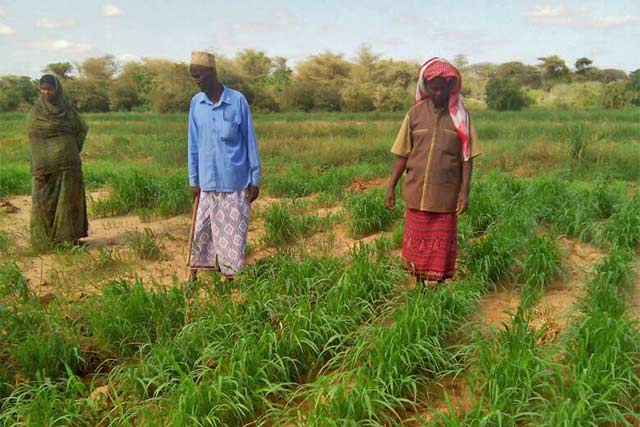 Framers inspecting their fodder grass fam. Photo courtesy.
Framers inspecting their fodder grass fam. Photo courtesy.
Women from Northeastern Kenya are unleashing their potential in the production, storage and sales of fodder grass and slowly earning them economic independence and key position in fighting food insecurity among pastoralist community in the region.
Initially these women who were not part of community decision-making and were left behind in food production process are so far able to sell hay bales and are, therefore, no longer dependent on men for most of their upkeep thanks to training on pasture grass production by the United Nations Food and Agriculture Organization (FAO).
In this training men, women and youth form groups of 20 to 30 people where producing, managing and utilizing fodder are taught in a 'school without walls’ through experiential and participatory sessions.
"For pastoralist families, food security is improved and incomes are higher. Meaning, communities have become a lot more resilient,” said Khalif Ibrahim Barrow, FAO/IGAD Partnership Programme.
The training targets Mandera County which is composed of arid and semi-arid areas and forms part of a cross-border region between Ethiopia, Kenya and Somalia where pastoralist communities are highly vulnerable to recurrent droughts that degrade rangelands and reduce access to traditional grazing areas.
RELATED ARTICLE: Refugee changing her life by growing sweet potato, okra and kale in her camp kitchen garden
As part of a partnership programme on drought resilience, FAO, the Intergovernmental Authority on Development (IGAD) and others have formed a total of ten Agro Pastoral Field Schools (APFS) across five project sites.
At the field schools, participants study each stage of feed production and preservation from preparing the land to planting seeds and whether to water by rain or irrigation right up to harvesting, and preserving and storing pasture seeds and hay bales.
"Like any other crop, pasture can be grown, nurtured and stored for use in times of need, allowing for a great rate of recovery of degraded land when rested," said Paul Opio, FAO livestock and pastoralism expert.
The learning cycle takes four months to complete and is offered twice a year, matching the rainy seasons. Farmers are also taught the best ways to remove invasive weeds, notably "Prosopis spp," which is accelerating the rate of degradation of rangeland ecosystems.
RELATED ARTICLE: Drought tolerant fodder maize gives eight tonnes per acre
The field schools use comparative experimentation as a key learning method. For example, participants observe how two similarly planted plots treated in different ways develop over various stages. They also analyze and discuss innovative problem-solving techniques and explore new methods to improve breeding and animal husbandry practices.
"As a result of the APFS, we are seeing improved pasture availability and restoration of degraded lands, while livestock body conditions have improved and mortality has been reduced," Khalif Ibrahim Barrow, a focal point for the Mandera County FAO/IGAD Partnership Programme, summed up the schools' benefits.
Pastoralists in the northeastern Kenya face chronic annual drought problems and most of the time they depend on the government initiatives for help.
In February this year the Ministry of Agriculture was forced to release Sh538m for livestock buying due to drought which saw farmers lose their animals. The animals were transported to Kenya Meat Commissioner (KMC) for slaughtering before they could all succumb to drought.
RELATED ARTICLE: Maasai herder adopts smart way to avert drought loses
February is normally the peak of drought season in Kenya while November is the peak month for the short-rains season, according to the Kenya Meteorological Department.
















Comments powered by CComment